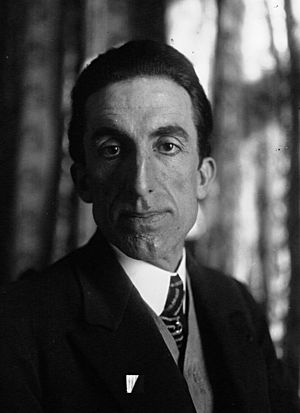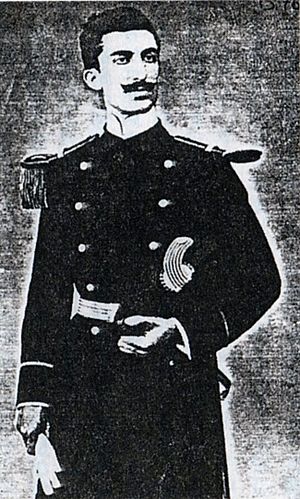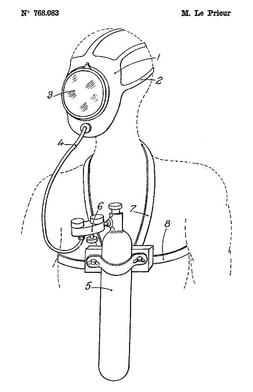Yves Le Prieur facts for kids
Quick facts for kids
Yves Le Prieur
|
|
|---|---|
 |
|
| Born | 23 March 1885 |
| Died | 1 June 1963 |
| Occupation | Naval officer, inventor |
Yves Paul Gaston Le Prieur (born March 23, 1885 – died June 1, 1963) was a French Navy officer and an amazing inventor. He created many important things, from rockets for airplanes to the first self-contained diving gear!
Contents
Adventures in Asia
Like his father, Yves joined the French Navy. As an officer, he worked in Asia. He even used old-fashioned deep-sea diving gear there.
He learned Japanese so well that he became a military helper and translator at the French embassy in Tokyo. While there, he achieved two amazing "firsts":
- He was the first Frenchman to earn a Black Belt in Judo.
- He was the first person to fly a glider from Japanese soil in 1909.
Le Prieur's Glider
His glider was called Le Prieur No. 2. It was 7.2 meters long and 7.0 meters wide. It weighed only 35 kilograms. The glider's frame was made from Japanese bamboo. It was covered with a fabric called calico.
Le Prieur designed the glider with help from Shirou Aibara, a Japanese Navy Lieutenant. He also worked with Aikitsu Tanakadate, a professor at Tokyo Imperial University. The first flight happened in December 1909. It took off from Shinobazu Pond, near the University of Tokyo. Le Prieur sat on the glider's main wing. His first flight covered 200 meters and reached an altitude of 10 meters.
World War I Inventions
During World War I, Le Prieur invented a special rocket launcher for airplanes. This invention helped planes shoot down enemy observation balloons. These balloons were used by the Germans to watch troop movements.
Rocket Launcher for Airplanes
His rocket system allowed an airplane to fire a group of rockets quickly. The original idea was for them to launch at the same time. However, due to technical issues in 1916, they fired one after another. This weapon was very good at destroying German balloons. It was only stopped when new types of bullets, like tracer rounds and incendiary bullets, became common. These new bullets worked similarly but allowed planes to carry more ammunition.
Le Prieur also designed special mechanical sights for guns. These sights helped calculate where to aim. They were used for both ship-to-ship battles and anti-aircraft guns.
Inventing Scuba Diving Gear
In 1925, Le Prieur saw a demonstration in Paris. A diver was using a breathing device invented by Maurice Fernez. The Fernez device was simple: a T-shaped rubber mouthpiece. Air was pumped from the surface through a long tube to one side. Used air escaped through a rubber valve on the other side. The diver wore nose clamps and small goggles.
The First Self-Contained Unit
Le Prieur was impressed by how simple the Fernez equipment was. He liked how much freedom it gave the diver. He immediately thought of a way to make it even better. He wanted to remove the tube connecting to the surface pump. His idea was to use Michelin air cylinders as the air supply. These cylinders held three liters of air compressed to 150 kg/cm2. Michelin supplied them to garages for inflating car tires.
Le Prieur talked to Fernez, who agreed to help modify his equipment. On August 6, 1926, they showed off the "Fernez-Le Prieur" diving apparatus. This happened at the Tourelles swimming pool in Paris. The new unit had a compressed air cylinder on the diver's back. It connected to a pressure regulator designed by Le Prieur. The diver could adjust this regulator by hand. It had two gauges: one for the tank pressure and one for the air supply pressure. Air flowed continuously to the mouthpiece. Excess air escaped through a short exhaust pipe, just like in Fernez's original design.
For the very first time, a person could breathe underwater without any connection to the surface! Le Prieur had invented the open-circuit self-contained underwater breathing apparatus, or SCUBA.
Improving the Diving Mask
Fernez's separate goggles had a problem. They didn't allow divers to go deeper than ten meters. As a diver went deeper, the water pressure squeezed the goggles onto their face. This painful problem is called "mask squeeze".
In 1933, Le Prieur found a solution. He replaced the goggles, nose clip, and valve with a full face diving mask. This mask was directly supplied with air from the cylinder. This balanced the pressure inside the mask with the water pressure outside. Le Prieur noted that divers could breathe through their mouth or nose. He even said it was possible to talk to another diver by bringing the mask close to their ear. The glass acted like a microphone!
In 1934, Le Prieur received a French patent for his improved scuba set. This new design had a hand-controlled air supply and a full face mask. The patent application was filed in Paris on February 2, 1934. The patent was granted on May 7, 1934. The equipment delivered air at a steady pressure. It did not use a demand regulator, which gives air only when the diver breathes in. The compressed air cylinder was worn on the diver's chest. Air flowed to the full face mask at a pressure controlled by a hand-operated valve. Extra air and exhaled breath escaped by slightly lifting the edges of the mask.
First Diving Club
In 1935, Le Prieur and Jean Painleve created the first diving club in France. It was called "club des scaphandres et de la vie sous l'eau." This means "the club for divers and life under water."
In 1946, Le Prieur made another improvement to his scuba set. The front plate of his full-face mask was loose. It acted like a very large, sensitive diaphragm for a demand regulator. This made the air supply even more efficient.



